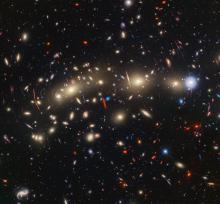Listen to today's episode of StarDate on the web the same day it airs in high-quality streaming audio without any extra ads or announcements. Choose a $8 one-month pass, or listen every day for a year for just $30.
You are here
Moon and Jupiter
The biggest moon in the solar system is an ocean world. It may have as much liquid water as all of Earth’s oceans combined. Don’t start looking for beachfront property, though — the ocean is buried below a hundred miles of ice.
Ganymede is a moon of Jupiter. It’s about 3300 miles in diameter — half again the size of our moon. And it’s about three times farther from Jupiter than the Moon is from Earth. Some of its surface is covered by impact craters, while the rest features long, deep grooves.
Ganymede is the only moon in the entire solar system that produces its own magnetic field. And that’s key to the discovery of its buried ocean. As Ganymede rotates, the salty ocean creates an imprint on the moon’s magnetic field. The Galileo spacecraft measured hints of that as it orbited Jupiter. But it got only brief glimpses as it sped past Ganymede.
Hubble Space Telescope got a better idea by looking at Ganymede’s aurora — like the northern lights here on Earth. Interactions between the magnetic fields of Ganymede and Jupiter cause the aurora to rock back and forth. The size of that rocking motion hints at the internal ocean, and even provides some of the details about it — a deep ocean on a giant moon.
Jupiter is close to our Moon tonight. It looks like a brilliant star. Binoculars reveal Ganymede and Jupiter’s three other big moons. They look like tiny stars lined up near the solar system’s biggest planet.
Script by Damond Benningfield





